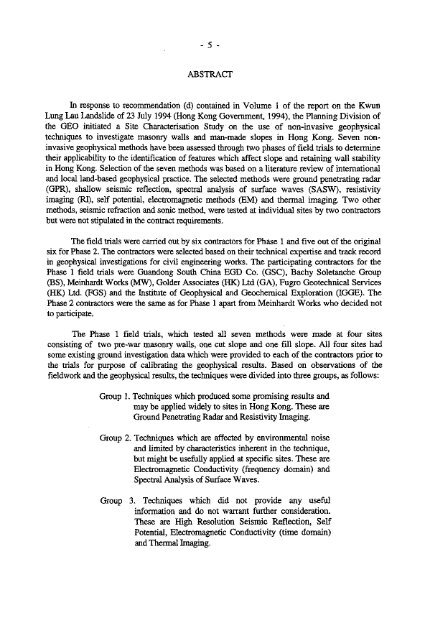site characterisation study - phases 1 and 2 - HKU Libraries - The ...
site characterisation study - phases 1 and 2 - HKU Libraries - The ...
site characterisation study - phases 1 and 2 - HKU Libraries - The ...
- No tags were found...
You also want an ePaper? Increase the reach of your titles
YUMPU automatically turns print PDFs into web optimized ePapers that Google loves.
- 5 -ABSTRACTIn response to recommendation (d) contained in Volume 1 of the report on the KwunLung Lau L<strong>and</strong>slide of 23 July 1994 (Hong Kong Government, 1994), the Planning Division ofthe GEO initiated a Site Characterisation Study on the use of non-invasive geophysicaltechniques to investigate masonry walls <strong>and</strong> man-made slopes in Hong Kong. Seven noninvasivegeophysical methods have been assessed through two <strong>phases</strong> of field trials to determinetheir applicability to the identification of features which affect slope <strong>and</strong> retaining wall stabilityin Hong Kong. Selection of the seven methods was based on a literature review of international<strong>and</strong> local l<strong>and</strong>-based geophysical practice. <strong>The</strong> selected methods were ground penetrating radar(GPR), shallow seismic reflection, spectral analysis of surface waves (SASW), resistivityimaging (RI), self potential, electromagnetic methods (EM) <strong>and</strong> thermal imaging. Two othermethods, seismic refraction <strong>and</strong> sonic method, were tested at individual <strong>site</strong>s by two contractorsbut were not stipulated in the contract requirements.<strong>The</strong> field trials were carried out by six contractors for Phase 1 <strong>and</strong> five out of the originalsix for Phase 2. <strong>The</strong> contractors were selected based on their technical expertise <strong>and</strong> track recordin geophysical investigations for civil engineering works. <strong>The</strong> participating contractors for thePhase 1 field trials were Gu<strong>and</strong>ong South China EGD Co. (GSC), Bachy Soletanche Group(BS), Meinhardt Works (MW), Golder Associates (HK) Ltd (GA), Fugro Geotechnical Services(HK) Ltd. (FGS) <strong>and</strong> the Institute of Geophysical <strong>and</strong> GeochemicaJ Exploration (IGGE). <strong>The</strong>Phase 2 contractors were the same as for Phase 1 apart from Meinhardt Works who decided notto participate.<strong>The</strong> Phase 1 field trials, which tested all seven methods were made at four <strong>site</strong>sconsisting of two pre-war masonry walls, one cut slope <strong>and</strong> one fill slope. All four <strong>site</strong>s hadsome existing ground investigation data which were provided to each of the contractors prior tothe trials for purpose of calibrating the geophysical results. Based on observations of thefieldwork <strong>and</strong> the geophysical results, the techniques were divided into three groups, as follows:Group 1. Techniques which produced some promising results <strong>and</strong>may be applied widely to <strong>site</strong>s in Hong Kong. <strong>The</strong>se areGround Penetrating Radar <strong>and</strong> Resistivity Imaging.Group 2. Techniques which are affected by environmental noise<strong>and</strong> limited by characteristics inherent in the technique,but might be usefully applied at specific <strong>site</strong>s. <strong>The</strong>se areElectromagnetic Conductivity (frequency domain) <strong>and</strong>Spectral Analysis of Surface Waves.Group 3. Techniques which did not provide any usefulinformation <strong>and</strong> do not warrant further consideration.<strong>The</strong>se are High Resolution Seismic Reflection, SelfPotential, Electromagnetic Conductivity (time domain)<strong>and</strong> <strong>The</strong>rmal Imaging.
















